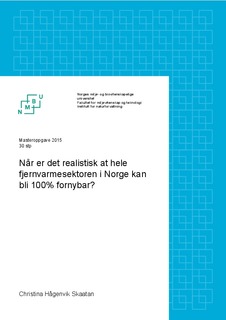| dc.description.abstract | Historically, the district-heating industry in Norway has been predominantly driven by fossil energy. More recently, however, there has been a dramatic increase in heat produced from renewable energy sources. This thesis aimed to discover exactly when it might be feasible for the entire district-heating sector in Norway to be driven exclusively by renewables. The focus here is on the transition from fossil fuels to renewable peak loads. It is assumed that bioenergy, electricity and heat from waste incineration can all be considered renewable.
The main method of data collection was through interview. Interviews were held with seven large district heating companies, as well as with the Norwegian water resources & energy directorate (NVE) and Enova. The thesis thus covers approximately 80% of the district heating networks in Norway. The levelized cost of energy (LCOE) was calculated to determine the resultant heat price, for 6 alternative cases. The present value method was also used to calculate profitability based on investmentcosts.
The results suggested that the average share of renewable energy for district heating in Norway today is about 95%, and not 85% as previously assumed. All of the interviewed companies revealed that they were aiming for 100% of heat to come from renewable sources, though for some companies this appeared to be more of a secondary or longer-term goal. In working towards the 100% target, the main motivating factors appeared to be climatic considerations and profitability as well as regulatory requirements.
It was concluded that whilst the district-heating sector could, technically speaking, have been renewable already, challenges, like profitability and quality of biooil, have made it likely to take a few more years. As long as certain prerequisites are met, most companies thought they would be renewable by 2020.
This thesis gives a realistic overview of the current situation in Norway’s district heating industry, as well as an indication of how it might develop in the future. The results may be particularly interesting for companies and stakeholders in the Norwegian district-heating sector. | nb_NO |
